5G Physical And MAC Layer Procedures Part-1 Updated In 2024
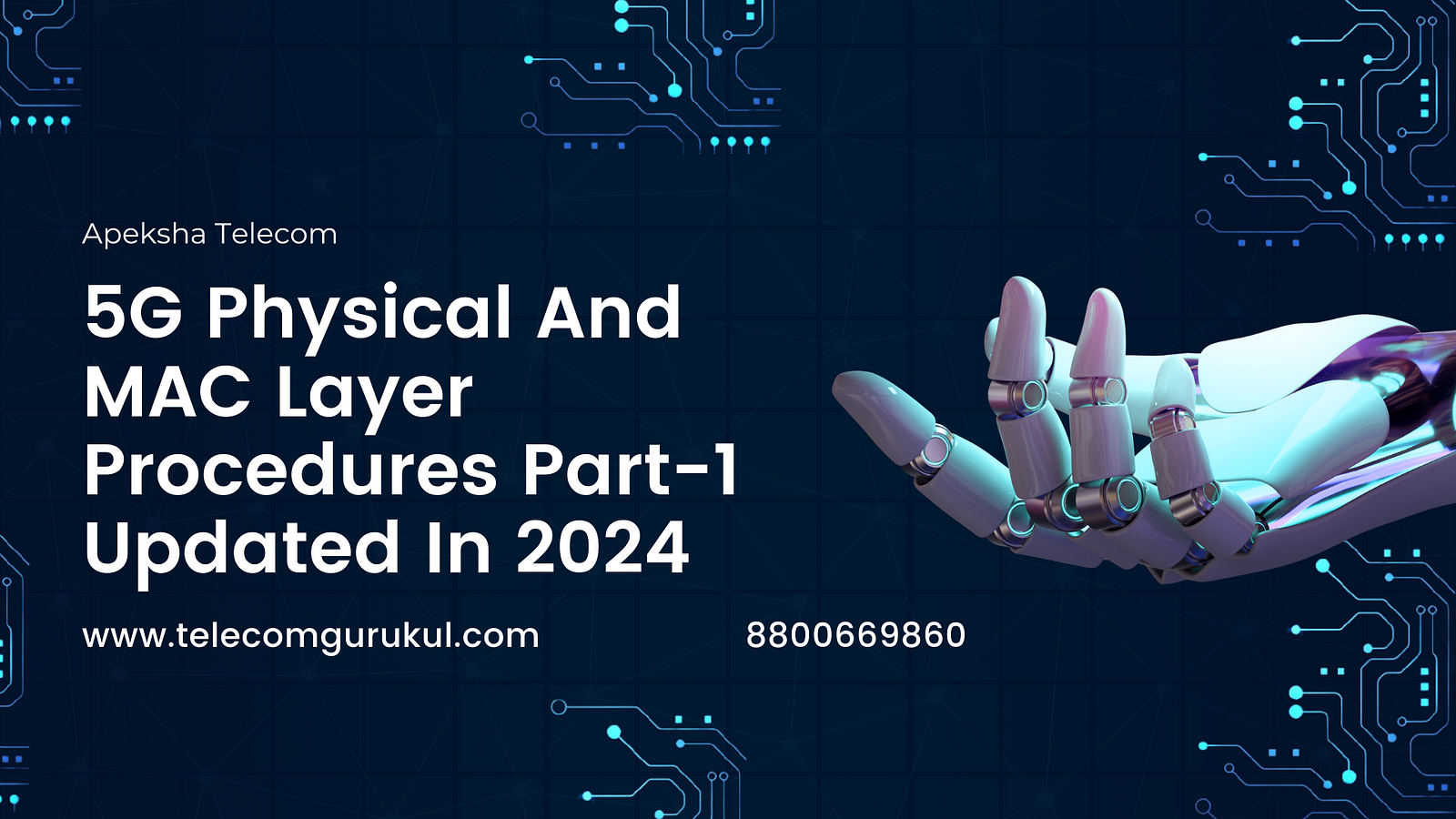
Introduction
In the realm of 5G technology, understanding the 5G physical and MAC layer procedures is crucial for anyone involved in telecommunications. This blog post delves into the intricacies of the Random Access procedures in 5G, focusing on the updated procedures as of 2024. We will explore the two main categories of Random Access: Contention Based Random Access (CBRA) and Contention Free Random Access (CFRA), providing a detailed overview of how they function, their use cases, and their significance in 5G networks.
Random Access Procedures In 5G
There are 2 categories of the Random Access procedure:
- Contention Based Random Access (CBRA)
- Contention Free Random Access (CFRA)
The ‘Contention Based’ procedure allows the UE to select a random access preamble from a pool of preambles shared with other UE. This means that the UE risks selecting the same preamble as another UE and subsequently experiencing contention. The ‘Contention Free’ procedure requires the Base Station to allocate a dedicated random access preamble. This removes the possibility of the UE experiencing contention. Both categories of procedure are illustrated at a high level in Figure below.

- If multiple UE select the same preamble for the ‘Contention Based’ procedure, those UE will decode the same content from the Random Access Response (MSG2). The Random Access Response provides the uplink resource allocation for MSG3, so each UE which decoded the same MSG2 content will transmit MSG3 using the same set of Resource Blocks and symbols. The Base Station will decode one of those MSG3 and will then complete Contention Resolution. If MSG3 included a CCCH message then Contention Resolution is based upon a MAC Control Element within MSG4. lf MSG3 included a DCCH message or DTCH data then Contention Resolution is achieved by addressing the UE on the PDCCH by its C-RNTI. Contention Resolution allows the group of UE which transmitted the same preamble to deduce which MSG3 was decoded by the Base Station and thus deduce which UE has successfully completed the Random Access procedure. The remaining UE continue the procedure with another preamble transmission.
- In the case of the ‘Contention Free’ procedure, the UE is provided with a dedicated preamble using either RRC signalling or Layer1 signalling, i.e. the allocated preamble can be specified within an RRC message or within Downlink Control Information (DCI) on the PDCCH.
- Table below presents a list of procedures which rely upon Random Access. All of these procedures can use Contention Based Random Access, while only a subset can use Contention Free Random Access (Contention Free Random Access requires the Base Station to have an opportunity to allocate a dedicated preamble).
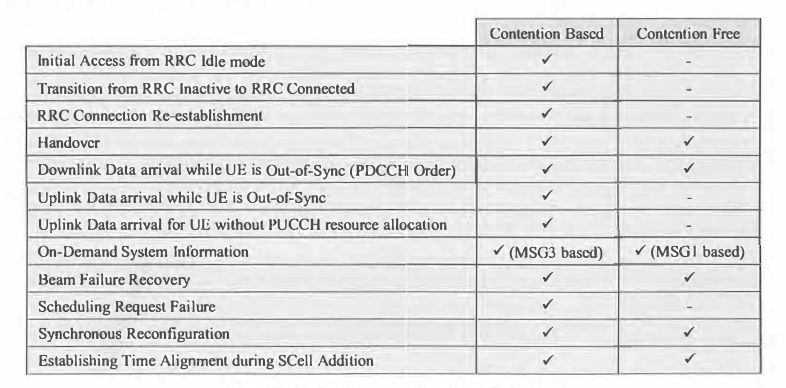
- UE making the transition from RRC Idlc to RRC Connected use MSG3 to send the RRCSetupRequest. Similarly, UE making the transition from RRC Inactive to RRC Connected use MSG3 to send the RRCResumeRequest (or RRCResumeRequest). In both cases the Contention Based procedure is used and the UE is responsible for selecting a PRACH preamble from the pool or preambles.
- UE completing the RRC Connection Re-establishment procedure use MSG3 to send the RRCReestablishmentRequest. This procedure also relies upon Contention Based Random Access.
- The handover procedure can use either Contention Based or Contention Free Random Access. In the case of Contention Free Random Access, the Base Station provides theUE with a specifies PRACH preamble using the RACH-ConflgDedicated parameter structure within the RRCReconfiguration message. In the case of Contention Based Random Access, the Base Station excludes the PRACH preamble allocation. The RRCReconfiguration message acts as the handover command. The UE uses MSG3 lo send the RRCReconfigurationComplete message which acts as the acknowledgement to indicate handover completion. The Contention Free Random Access procedure is preferred for handovers due to its increased reliability and lower latency.
- A ‘PDCCH Order’ is used to trigger the Random Access procedure when downlink data arrives for a UE which has lost uplink synchronisation while in RRC Connected mode, i.e. Timing Advance Commands have not been used to maintain uplink synchronisation and the TimeAlignmentTimer has expired. The Random Access Procedure is used to re-synchronise the UE prior to forwarding the downlink data. A ‘PDCCH Order’ is signalled using DCI Format 1_0 (presented in section 3.5.6). A ‘PDCCH Order’ can trigger either the Contention Based or the Contention Free Random Access procedure by excluding or including a PRACH preamble index within the DCI. A ‘PDCCH Order’ does not require an RRC message to be transferred for MSG3. Instead a C-RNTI MAC Control Element is included within MSG3. This C-RNTI is used for Contention Resolution when using Contention Based Random Access
- A UE uses the Contention Based Random Access procedure if uplink data arrives while the UE has lost uplink synchronisation in RRC Connected mode. Similar to the downlink scenario, the Random Access procedure is used to re-synchronise the UE prior to transferring the data. The UE is not required to send an RRC message within MSG3 but sends a C-RNTI MAC Control Element which is subsequently used for Contention Resolution.
- A UE is typically allocated a set of PUCCH resources to send Scheduling Requests. If a UE has not been allocated any PUCCH resources then it can use the Contention Based Random Access procedure to obtain an uplink resource allocation, i.e. MSG3. The UE is not required to send an RRC message within MSG3 but sends a C-RNTI MAC Control Element instead. If the UE requires additional uplink resource allocations, MSG3 may also include a Buffer Status Report (BSR) MAC Control Element.
- On-demand System Information can be requested using either MSG1 or MSG3.
- si-RequestConfig is included within SIB 1 if the Base Station supports ‘On-demand’ SIB requests using MSG 1. In this case, the UE transmits a specific PRACH preamble to request a specific SIB, or a specific set of SIB. This procedure only requires MSG1 and MSG2 so corresponds to the Contention Free Random Access procedure. After receiving MSG2, the UE scans the PDCCH for System Information resource allocations
- The Base Station relics upon ‘On-demand’ SIB requests using MSG3 if si-RequestConfig is excluded from SIB 1 while at least one SIB has si-BroadcastStatus set to ‘notBroadcasting’. ln this case, MSG3 is used to transmit the RRCSystemlnfoRequest. This procedure requires the UE to select a PRACH preamble from the normal pool of preambles so the procedure is Contention Based and requires the Base Station to return MSG4 for contention resolution.
- Beam Failure Recovery uses the Random Access procedure to allow rapid recovery without the requirement for RRC signalling. In the case of the Contention Free procedure, the Base Station provides the UE with a PRACH preamble index for each beam available for recovery. This allows the Base Station to identify the beam which has been selected by the UE. The beam used for recovery can be either an SS/PBCH beam or a CSI Reference Signal beam. In the case of the Contention Based procedure, the UE selects a PRACH preamble which corresponds to the SS/PBCH beam targeted for recovery.
- A UE reverts to using the Contention Based Random Access procedure if a Base Station does not provide an uplink resource allocation after the UE has sent a series of Scheduling Requests on the PUCCH. The upper limit for the number of Scheduling Request attempts is defined by sr-TransMax. In this case, the Random Access procedure is used as an alternative mechanism for requesting uplink resources.
- The Base Station can instruct a UE. to complete a synchronous reconfiguration by including the reconfiguration With Sync parameter structure within an RRCReconfiguration message. This triggers the UE to complete a Random Access procedure which then allows both the UE and Base Station to subsequently apply the new configuration at the same time. The Base Station can specify a specific PRACH preamble within the reconflguration With Sync parameter structure for the Contention Free Random Access procedure.
- The Random Access procedure can be used to initialise Timing Advance when adding a Secondary Cell which belongs to a new Timing Advance Group (TAG). This may be applicable if the new Secondary Cell is not co-sited with the existing serving cells so experiences a different propagation delay. The Random Access procedure allows the Base Station to initialise the Timing Advance for the new Secondary Cell. The UE subsequently maintains Timing Advance for each Timing Advance Group. Similar to the synchronous reconfiguration procedure, the Base Station can specify a specific PRACH preamble within the reconfigurationWithSync parameter structure for the Contention Free Random Access procedure.
Contention Based
The UE requires knowledge of the available PRACH preambles and PRACH occasions before it can initiate the Contention Based Random Access Procedure. The Base Station uses the RACH-ConjigCommon parameter structure shown in Table below to provide this information either within SIB 1 or using dedicated signalling. The parameters within RACH-ConfigCommon will be referenced throughout the remainder of this section.
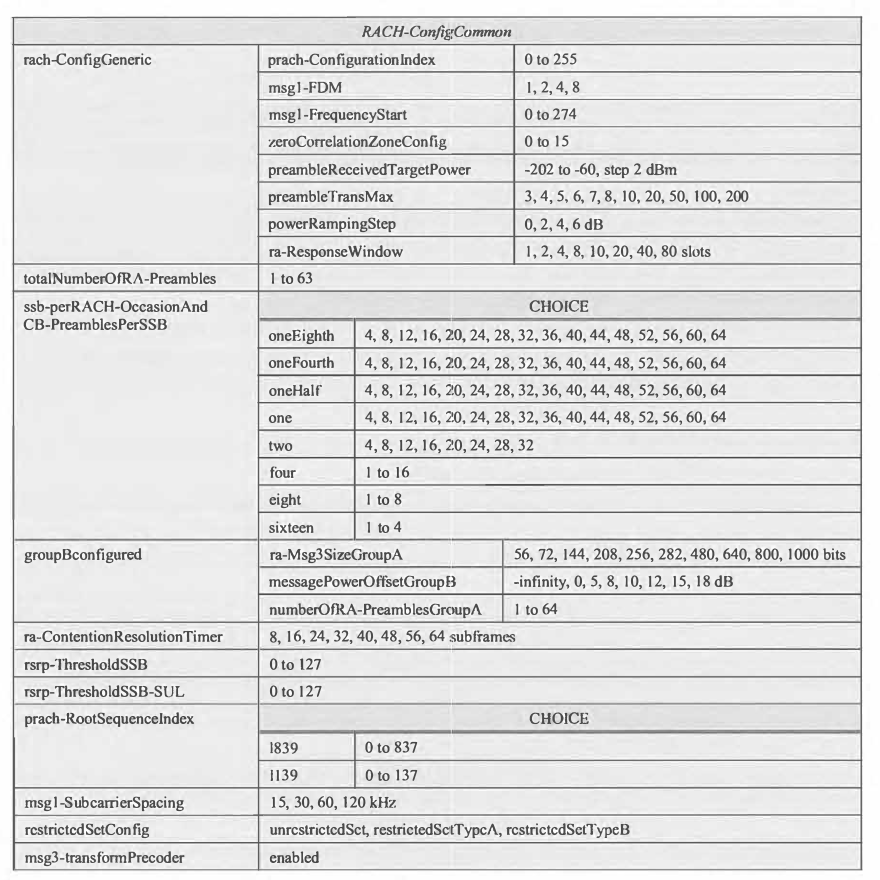
- A UE starts by identifying the PRACH Preambles which belong to the pool for Contention Based Random Access. The UE already knows that every PRACH occasion offers a maximum of64 preambles, numbered from 0 to 63. The total Number of RA-Preambles quantifies the total number of preambles per PRACH occasion which are available for both the Contention Based and Contention Free Random Access procedures (excluding preambles which have been reserved, e.g. preambles which have been reserved for on-demand System Information requests). This parameter has a range from 0 to 63 so it is used when less than 64 preambles are available. Excluding this parameter from RACH-ConfigCommon indicates that all 64 preambles arc available.

- ssb-perRACH-OccasionAndCB-PreamblesPerSSB allows the UE to quantify the number of Contention Based PRACH preambles associated with each SS/PBCH beam. This parameter can be divided into two parts with ssb-perRACH-Occasion defining the number of SS/PBCH beams sharing the same PRACH occasion, i.e. sharing the same set of 64 preambles. Figure below illustrates examples with 1 beam per PRACH occasion, 1/2 beam per PRACH occasion and 2 beams per PRACH occasion. This relationship determines the total number ofpreambles available to each beam. CB-PreamblesPerSSB defines the number of Contention Based preambles per PRACH occasion which are available to a specific beam.

- Figure below illustrates the grouping of the PRACH preambles belonging to a single PRACH occasion when the number of SS/PBCH Beams per PRACH occasion is 2.

- Before selecting a specific preamble from the appropriate group, the UE must select an SS/PBCH beam. The UE prioritises beams which have a Layer 1 RSRP exceeding the value of rsrp-ThresholdSSB (or rsrp-ThresholdSSB-SUL when using a Supplemental Uplink carrier). The UE is permitted to select any beam if none of the beams have a Layer 1 RSRP measurement which exceeds the threshold. Selecting a PRACH preamble which is linked to a specific SS/PBCH beam allows the Base Station to deduce the best beam for subsequent transmissions
- Figure below summarises the overall procedure for PRACH preamble selection.
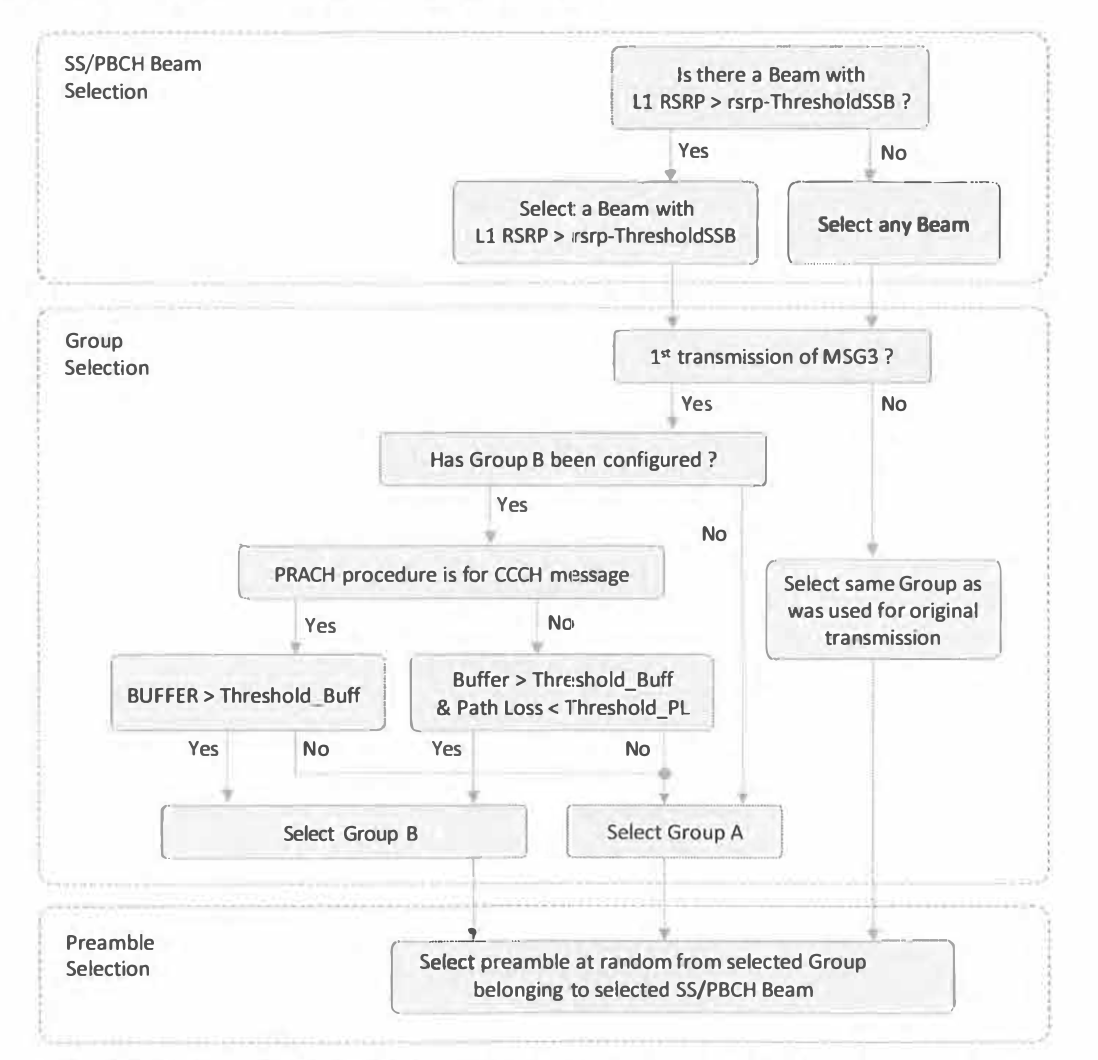
- Once the PRACH preamble has been selected, the UE is required to generate the corresponding PRACH sequence for transmission within that preamble (a PRACH preamble consists of one or more repetitions of a sequence plus a cyclic prefix). The sequence is generated using a combination of the selected PRACH preamble index, prach-RootSequencelndex, zeroCorrelationZoneConfig and restrictedSetConfig. The Root Sequence index, Zero Correlation Zone configuration and the use of Restricted Sets are typically configured as part of Radio Network Planning.
- The zero Correlation Zone Config is determined by the cell range requirement. Larger cell ranges require larger cyclic shifts when generating the PRACH preambles from the Root Sequence. The Zero Correlation Zone configuration determines the size of the cyclic shift.
- The zero Correlation Zone Config also determines the number of Root Sequences required per cell when generating the set of 64 preambles belonging to each PRACH occasion. Larger cell ranges require an increased number of Root Sequences due to the larger cyclic shill. For example, if a Root Sequence has a length of 839 digits and a cyclic shift of 119 is used then it is possible to generate ROUNDDOWN (839 / 119) = 7 sequences from each Root Sequence. This means that ROUNDUP (64 17) = 10 Root Sequences are required to generate the set of 64 PRACH preambles belonging to each PRACH occasion (the same set of 64 sequences are re-used for all time multiplexed and frequency multiplied PRACH occasions belonging to a specific cell). For this example, Radio Network Planning would allocate Root Sequences to cells using a step size of 10 because every cell requires 10 Root Sequences.
- prach-RootSequencelndex identifies the first Root Sequence used by a cell. For example, if prach-RootSequencelndex = 50 and a cell requires 10 Root Sequences to generate the set of 64 PRACH preambles, then the cell would use Root Sequences {50, 51, 52, 53, 54, 55, 56, 57, 58, 59}, and a neighbouring cell could be allocated prach-RootSequencelndex = 60. It should be noted that these are ‘logical’ Root Sequence indices which are mapped onto ‘physical’ Root Sequence indices using a look-up table specified by 3GPP TS 38.211. The ‘logical’ Root Sequence indices are consecutive but the ‘physical’ root sequence indices are not consecutive.
- reslrictedSetConflg is normally configured as ‘unrestrictedSet’. The ‘restrictedSctTypeA’ and ‘restrictedSetTypeB’ values are applicable to high speed and very high speed deployment scenarios when using Long PRACH Formats. They provide increased resilience to Doppler frequency offsets by restricting the set of preambles which can be generated from each Root Sequence.
- A UE is also required to identify the time and frequency domain positions of the PRACH occasions belonging to each SS/PBCH beam. This is achieved using the prach-ConifigurationIndexandmsg1-FDM parameters. 171 prach-Conif gurationIndex defines a pointer to a row within a look-up table specified by 3GPP TS 38.211. There are separate PRACH Configuration Index tables for each duplexing method and Frequency Range.
- The Subframe Number indicates that PRACH occasions exist within subframes 4 and 9. This example is based upon TDD so there is a requirement to ensure that the relevant symbols within these subframes are configured for the uplink. The ‘Starting Symbol’ indicates that the PRACH occasions start at symbol ‘0’, while the ‘Number ofPRACH Slots within Subframe’ indicates that both slots belonging to the subframe include PRACH occasions. This column is applicable because this example is based upon the 30 kHz subcarrier spacing so there are 2 slots per subframe. This column does not provide any information when using the 15 kHz subcarrier spacing because there is only 1 slot per subframe (this example is based upon Frequency Range I so only the 15 kHz and 30 kHz subcarrier spacings arc applicable to the PRACH).
- The ‘Time Domain PRACH Occasions within PRACH Slot’ indicates that 3 PRACH occasions are time multiplexed. The PRACH Duration indicates that each PRACH occasion occupies 4 symbols (corresponding to the duration of preamble format A2).
- This example provides a total of 12 time multiplexed PRACH occasions per 20ms. The number of PRACH occasions can be further increased by frequency multiplexing if the value of msg 1-FDM is greater than 1.
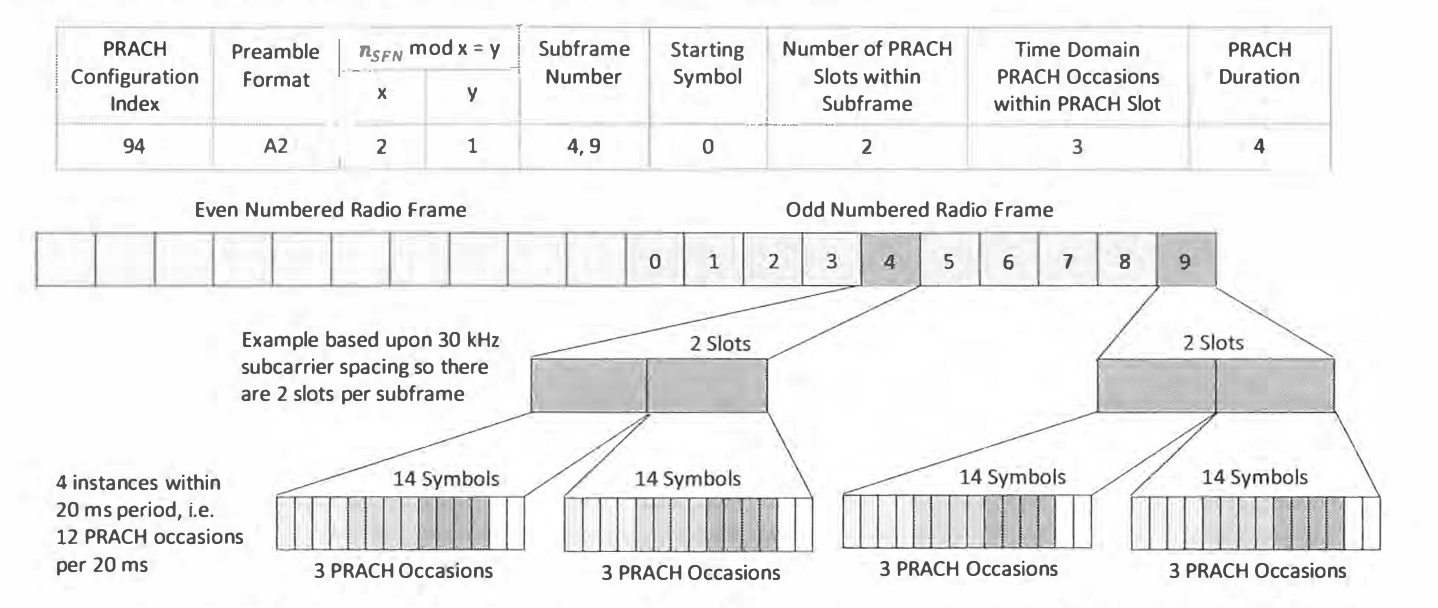
- Figure 351 illustrates an example of the timing for Short PRACH Preamble Format A2 when using the 120kHz subcarrier spacing for TDD within Frequency Range 2. This example is based upon a PRACH Configuration Index of “38'. The values of ·x’ and “y’ indicate that PRACH occasions only exist within odd numbered radio frames, i.e. n.ffN mod 2 = 1. This also indicates that the PRACH Configuration Period is 20 ms.
- The previous example was based upon Frequency Range 1 and the look-up table included a subframe Number’ column. This second example is based upon Frequency Range 2 and the ‘Subframe Number’ column is replaced by a ‘Slot Number’ column. Slot numbering is based upon the 60 kHz subcarrier spacing so there are 40 slots per radio frame.
- The Slot Number indicates that PRACH occasions exist within 60kHz slots {4,9,14,19,24,29,34,39}. Similar to the first example, this example is based upon TDD so there is a requirement to ensure that the relevant symbols within these slots are configured for the uplink. The ‘Starting Symbol’ indicates that the PRACH occasions start at symbol ‘0’, while the ·Number of PRACH Slots within 60 kHz Slot’ indicates that only the first slot belonging to the 60 kHz slot includes PRACH occasions. This column is applicable because this example is based upon the 120 kHz subcarrier spacing so there are 2 slots per 60 kHz slot. This column docs not provide any information when using the60 kHz subcarrier spacing because there is only 1 slot per 60 kHz slot (this example is based upon Frequency Range 2 so only the 60 kHz and 120 kHz subcarrier spacings are applicable to the PRACH).
- The ‘Time Domain PRACH Occasions within PRACH Slot’ indicates that 3 PRACH occasions are time multiplexed. The PRACH Duration indicates that each PRACH occasion occupies 4 symbols (corresponding to the duration of preamble format A2).
- This example provides a total of 24 time multiplexed PRACH occasions per 20ms. The number of PRACH occasions can be further increased by frequency multiplexing.
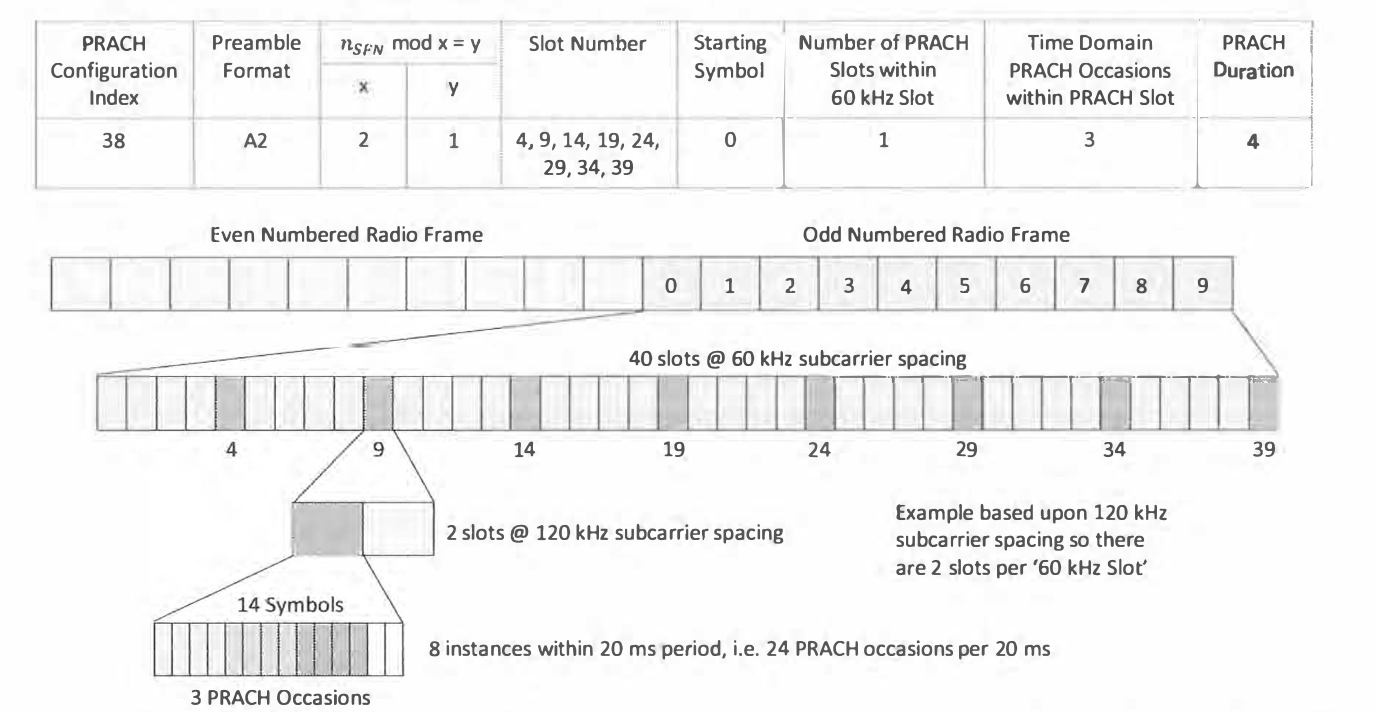
- Figure below illustrates the general concept of frequency multiplexing PRACH occasions. msg1-FDM specifies the number of PRACH occasions which are multiplexed in the frequency domain. Figure below is based upon msg1-FDM= 4. The frequency multiplexed PRACH occasions occupy a contiguous set of Resource Blocks within the uplink Bandwidth Part.
- msg1-FrequencyStart specifics the position of the lowest Physical Resource Block (PRB) belonging to the first PRACH occasion. Resource Block numbering is based upon the subcarrier spacing used by the PUSCH within the uplink Bandwidth Part.
- The number of PUSCH Resource Blocks occupied by each PRACH occasion depends upon the subcarrier spacings of both the PRACH and the PUSCH. Figure below specifics that the PRACH occupies 6 Resource Blocks when the PRACH subcarrier spacing is 1.25 kHz and the PUSCH subcarrier spacing is 15 kHz (this configuration is equivalent to the most commonly used 4G configuration). The set of 6 Resource Blocks corresponds to a bandwidth of 1080 kHz which allows a guard band either side of the PRACH transmission. When using a PRACH subcarrier spacing of 1.25 kHz and a PUSCH subcarrier spacing of60 kHz, the PRACH occupies 2 Resource Blocks which corresponds to a bandwidth of 1440 kHz, i.e. in this case, there is a larger guard band either side of the PRACH transmission.
- The PRACH occupies 12 Resource Blocks when both the PRACH and PUSCH subcarrier spacings are 120 kHz. The set of 12 Resource Blocks corresponds to a bandwidth of 17.28 MHz, i.e. PRACH transmissions can occupy relatively large bandwidths when the subcarrier spacing is high.
- After identifying both time and frequency domain multiplexing, a UE knows the total number of PRACH occasions within a PRACH Configuration Period. It is then necessary to link each PRACH occasion to a specific SS/PBCH beam.
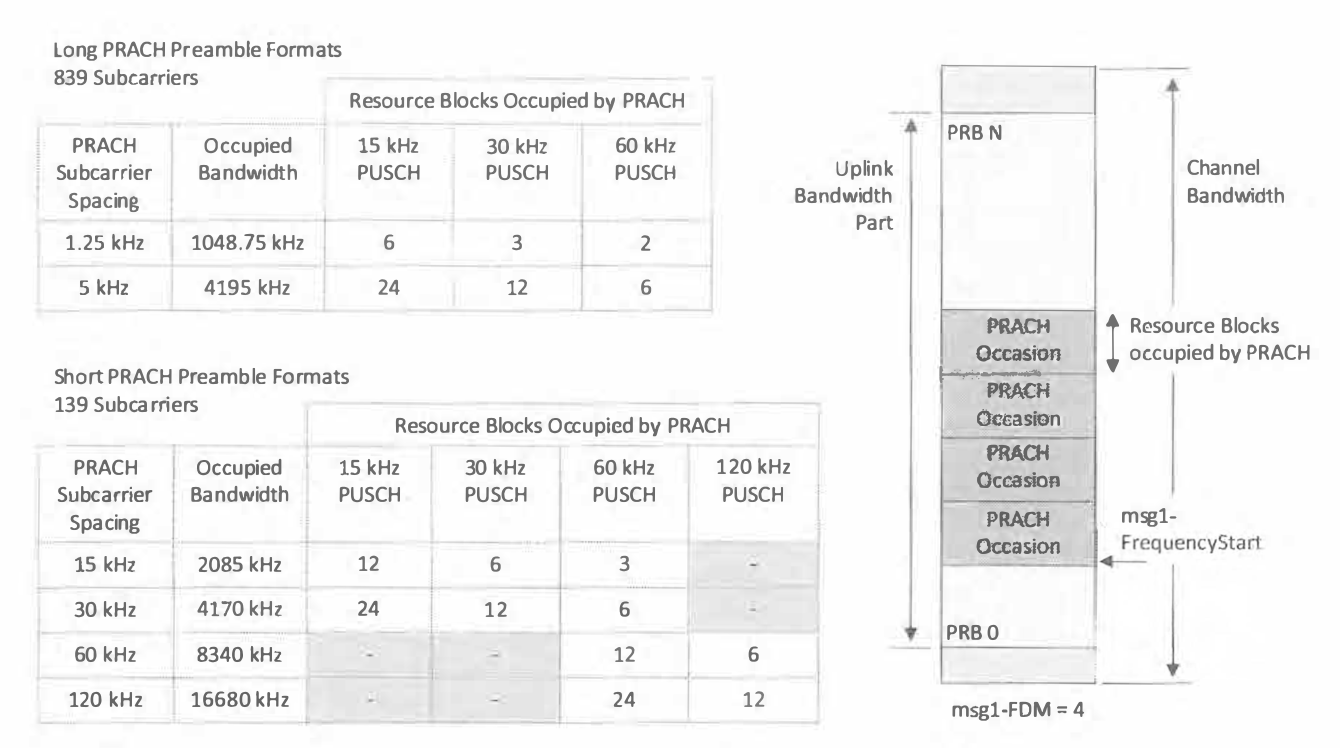
- A UE identifies an ‘Association Period’ as a minimum number of PRACH Configuration Periods which include sufficient PRACH occasions to allow every SS/PBCH beam to be mapped onto the set of PRACH occasions at least once. The number of PRACH Configuration Periods which can belong to an Association Period depends upon the PRACH Configuration Period. The set of permitted values is presented in Table below. The Association Period and the PRACH Configuration Period have maximum durations of 160 ms.
- For example, if there are 24 PRACH occasions within a 20ms PRACH Configuration Period, and if there 64 SS/PBCH beams with each beam configured to require 1 PRACH occasion then the Association Period is 80 ms (4 PRACH Configuration Periods). The 80 ms Association Period includes 4 x 24 = 96 PRACll occasions but only 64 of these PRACH occasions are mapped onto SS/PBCH beams. The remaining 32 PRACH occasions arc not used by the PRACH.

- As a second example, assume there arc 48 PRACH occasions within a 20 ms PRACH Configuration Period, and if there are 32 SS/PBCH beams with each beam configured to share a PRACH occasion with another beam, then the Association Period is 20 ms (1 PRACH Configuration Period). The 20 ms Association Period includes 1 x 48 = 48 PRACh occasions so each SS/PBCH beam is mapped 3 times within the Association Period and there are no unused PRACH occasions.
- Figure below illustrates an example with 24 PRACH occasions within a 10ms Association Period and 10 SS/PBCH beams. It is assumed that ssb-perRACH-Occasion = 1 so the set of 24 PRACH occasions allow 2 cycles of the 10 SS/PBCH beams with 4 PRACH occasions unused.
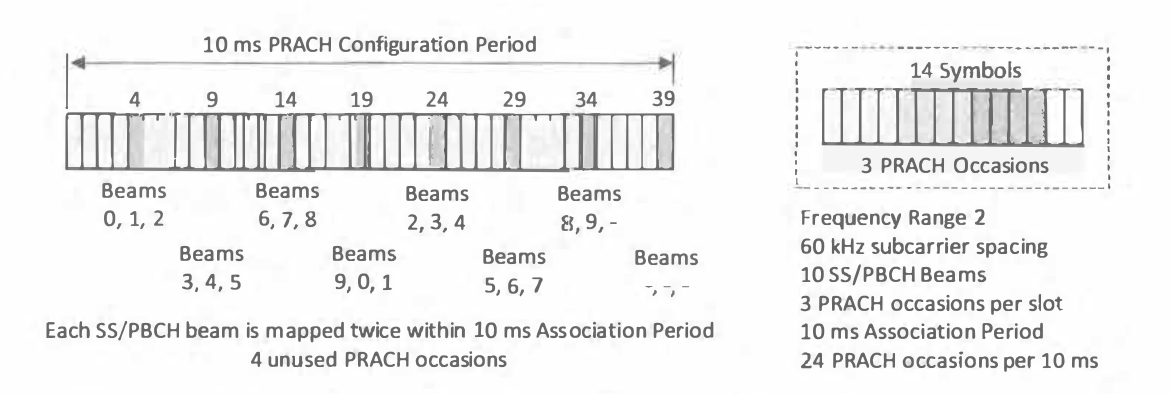
Conclusion
The updated 5G physical and MAC layer procedures offer a robust framework for efficient network operation, particularly in the context of Random Access procedures. Understanding these procedures, including the nuances of CBRA and CFRA, is essential for professionals working with 5G technology. As the technology evolves, staying informed about these updates will ensure optimal performance and reliability in 5G networks.
References
- 4G 5G Testing and protocol analysis
- Syllabus for 4G 5G Protocol Testing Training
- Contact Us for training
- Qualcomm Academy Videos
- 3GPP Website
- ShareTechNotes



Comments
Post a Comment